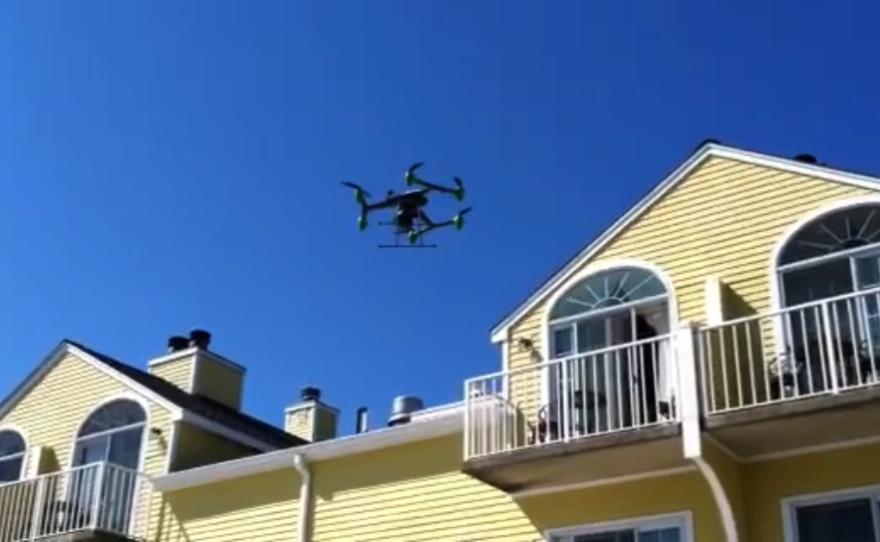Officials' estimates say that in the next twenty years there could be as many as 30,000 drones flying in US airspace. Depending on your point of view, that's either a great technological leap forward, or a very scary prospect. Businesses are similarly divided about our drone future.
Out of a beautiful fall sky, a drone - an unmanned aerial vehicle -- lands outside the Saybrook Point Inn, to a rapturous reception from a group of business executives. The green and black device is about three feet across, carries a video camera and weighs less than five pounds -- it looks like a tiny helicopter with four rotors. This demonstration has been arranged by the Connecticut Business and Industry Association -- CBIA's Eric Brown said this conference, the first of its kind in the state is about showing the business community the real potential of drones.
"Obviously," said Brown, "most people are familiar with drone technology when it comes to military operations. But both in scale of the vehicles and the technology involved, they’re now becoming important scientific tools as well as compliance tools."
Specifically in this setting, environmental compliance -- most of the companies here are large utilities, drug companies or manufacturers all of whom have to answer to the Environmental Protection Agency. "There are a variety of sensors that can be used to monitor air quality, water quality and soil contamination," Brown said, "and so this is becoming an important frontier for both regulatory agencies and for companies who have obligations to make sure their various activities are within environmental limits."
http://www.youtube.com/watch?v=JPd3cJFLo4I&feature=youtu.be
The demonstration, including a precision indoor flight, comes courtesy of Professor Massimiliano Lega of the University of Naples, a former aerospace engineer turned environmental expert who's something of a civilian drone pioneer. Lega has worked with the Italian coast guard to map pollution on the country's coastline. His technology has been responsible for apprehending tanker captains illegally dumping oil at sea.
With a thermal imaging camera mounted on a drone, Lega said he can pinpoint a single outflow of pollution from a seaside coffee shop. "We discovered that the drones or other types of aerial platform are the best way to have a special point of view on the environment," he said.
Matthew Hackman runs an environmental consulting agency in Rhode Island specializing in remediating contaminated sites. "As you go to a property," Hackman said, "you’re trying to map the property -- kind of hard to do often on the ground, or it would be labor intensive to take multiple people surveying, etc. So the ability to get a reasonable accurate, high quality aerial video, especially close up, would be helpful."
Of course aerial video is perfectly possible right now if you want to hire a plane and a pilot, but that could set you back tens of thousands of dollars. Lega's device can be hired in Europe right now for 500 Euros a day -- less than $700. And here, there are amateur drones for hobby use that you can buy on Amazon for less than $100.
That's something that concerns Brian Hearing. "They can be used for intellectual property theft," Hearing said. "[In] some cases they’ve put wifi hacking apparatus on drones, and landed them on your business to hack into your business." Hearing is the founder of Drone Shield, which makes an automated listening device that can warn you if a drone is near your property. "Could you sit out there and listen for a drone?" he asked. "Possibly, if you know what you’re listening for. The benefit of using a computer to do this: it’s on 24/7; you can set it around the perimeter of your property to give you enough warning when one’s coming."
Lots of companies are excited about the possibilities for reducing costs and cutting risk by using drones. Farmers can use them for spraying pesticides or counting livestock. Hearing said even in an industry that's embraced the technology, there are mixed feelings. "There’s been a great upswelling of farmers in the Midwest against the EPA," he said. "They’re accusing [others] of using drones to take overhead shots. Farmers are a special case, because their residence is on the same location as their business, so there are concerns about privacy there."
This explosion of activity around drones is taking place in a legal gray area. The FAA has yet to open U.S. airspace officially to civilian drones, and it may be 2015 before it formulates the rules for their use. In the meantime, it's issuing hundreds of special use permits -- to police departments, university researchers and to companies -- to utilities that want to survey power lines, or logging companies that want to take machinery into remote locations.
Only eight states have laws on the books about drones, but more than 40 are discussing them, and in the absence of an FAA framework, that's likely to lead to a confusing legal patchwork. Professor Lega said that issue is holding the industry back. "But we have a lot of limits that are not only limits for the company that want to use drones," he said, "but is a big limit also for the people that want to develop drones."
The rise of the drone has been compared to the advent of the automobile in the age of horse-drawn carriages. Those currently being made are the Model Ts of the age -- technological marvels to be sure, but nothing compared to what's to come. Whether you regard it as a great new efficiency or a worrying invasion of privacy, you can be sure it's going to change your life.







